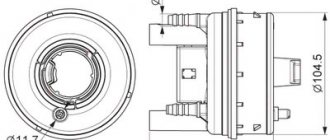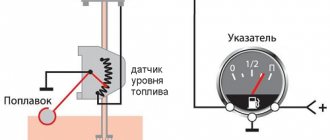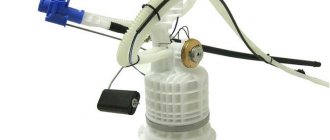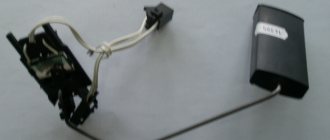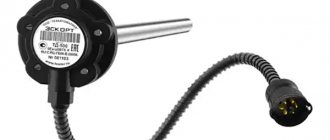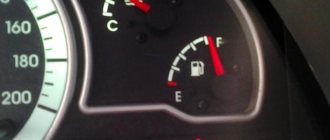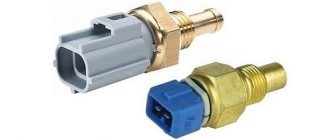It becomes extremely inconvenient to operate a car if the fuel level indicator on the dashboard is lying or not working. To avoid getting into a hopeless situation with an empty tank, the driver has to record the odometer readings and calculate the approximate mileage based on fuel consumption. Another option is to constantly carry a spare canister filled with gasoline or diesel fuel in the trunk. Getting rid of these inconveniences is a trip to a car service center or self-diagnosis and troubleshooting.
What to do
First you need to carry out diagnostics, that is, find out which part is damaged - the sensor, wiring or the indicator itself. For this, a regular multimeter is used, but you can replace it with a test lamp.
First you need to gain access to the fuel section and the fuel level sensor itself. To do this, with the car running, you need to remove the connector in the service hatch under the rear sofa of the car. Then, using the electrical supply diagram, you need to determine which wire goes from the sensor to the fuel indicator. One connector of the multimeter must be connected to the ground of the car, the other to the positive terminal of the wire coming out of the hole. The multimeter should show the on-board voltage (12 V). If you close the positive terminal to vehicle ground, the indicator arrow should show a full tank. If this does not happen, the wiring or the indicator itself is to blame. If the needle shoots up to the extreme position, the problem is in the fuel sensor.
Modern fuel sensors are best replaced as an assembly. Their price is not so high as to make repairs that do little to help the business. However, in some cases, you can try to clean the sensor from dirt and try to adjust the slider. To do this, you will have to remove the sensor (you must first drain the fuel, turn off the car and remove the negative terminal from the battery). After removing the sensor, you need to inspect the working surface of the sectors for wear. If the width of the wear line is small, you can adjust the slider so that it moves along the undamaged surface of the sectors.
If incorrect readings of the fuel level indicator are not associated with the fuel sensor, then you will have to remove the indicator from the dashboard. Wiring problems can also be diagnosed using a multimeter. The malfunction of the device itself is determined manually after removing the device - if the arrow is jammed, you can try to clean it and adjust it.
Reasons for replacement
You will definitely have to replace the sensor if the car starts to produce the following:
- The fuel level indicator needle “dances” or has fallen dead to the zero position;
- The indicator is constantly on, indicating a critical fuel level, although you have just filled the tank full.
FLS diagram
FLS on high and low panels
The differences in the sensors on the injectors and carburetors are minimal. Also, the fuel level sensors on VAZ 2109 cars equipped with a low and high panel are slightly different.
Fuel level sensor does not work
The FLS, like any other elements of the car, can systematically fail, resulting in the need for repair work. Now we will take a closer look at the most common causes of this phenomenon:
- If the FLS readings are constantly changing (“jumping”), it is possible that the contact tracks on the board are worn out, which are erased under the influence of time as a result of the device’s slider constantly moving along them. If the worn area is not large, try bending the slider so that it is located above the worn area; however, if the worn area is large, the problem can only be solved by replacing the sensor.
- It happens that when the fuel tank is full, the indicator arrow of the sensor returns to zero. A possible cause of this phenomenon is an incorrectly placed float stop.
- When the engine is running and the ignition is on, the indicator arrow remains stationary. As a rule, the reason lies in damage to the connecting wires, oxidation of their tips, a malfunction of the pointer receiver or a blown fuse.
- If the fuel level indicator needle constantly drops to zero and also twitches, you should check the current collector; it is probably not touching the sensor resistor enough, or the winding of the resistor has broken.
- In addition, the warning lamp about the minimum fuel level in the tank may stop working altogether or work incorrectly, intermittently. In this case, most likely the problem lies in the resistor and you may have to replace it.
The most common problem with potentiometric sensors is their rapid wear, as well as oxidation of the tracks, which determines the appearance of the problems described above.
We recommend: How to determine the wear of winter tires?
How does the device work?
To understand the problem yourself, you need to understand how the fuel level is measured and information is transmitted to the device indicator. The circuit implemented in most vehicles includes the following main elements:
- a float made of lightweight polymer is immersed in the gas tank and is often combined with the pump block;
- gasoline sensor – lever-type potentiometer (otherwise known as rheostat);
- pointer arrow with scale;
- connecting wires.
In many modern cars, an electronic control unit is connected to the system.
The classic rheostat is an open coil of high resistance wire. A lever equipped with a contact and attached to the float rises or falls with the level of fuel in the tank, and the contact moves along the turns of the winding. The classic scheme works simply:
- The rheostat and the pointer device are connected in series in the circuit, both are powered from the vehicle's on-board network.
- When moving the float with the lever, the resistance of the potentiometer changes.
- A change in resistance causes an increase or decrease in the current in the circuit, to which the indicator arrow reacts. The scale is graduated according to the resistance values corresponding to the filling of the gas tank.
The updated version of the system works with the participation of a controller. The fuel level arrow receives a processed digital signal from the electronic unit that supplies power to the potentiometer. The principle of operation does not change, but the circuit allows you to obtain more accurate readings.
Possible problems with the fuel level sensor
The operation of a car is accompanied by breakdowns of many components and assemblies, and the sensor that monitors fuel consumption is no exception. Violations in its operation can be manifested either by a complete failure or by errors in the information provided.
Malfunction in indicators
The following signs will allow you to timely identify malfunctions of the fuel control unit:
- the fuel level indicator arrow is not static, it is in constant motion, twitches, and can jump;
- when confidently refueling “to a full tank”, the fuel level indicator will show a partially filled or empty tank;
- when the engine is running, the needle does not deviate to the actual level of gasoline (diesel), but is in its original position;
- The problem may look like the warning light not warning you that the fuel level is extremely low.
Diagnosis is always necessary. In some cases, for example, if the indicator does not respond to starting the engine, it is possible that a fuse has blown or a loss of contact on one of the supply wires (checked by a tester); in others, the fault should be looked for in the mechanical part of the sensor.
Mechanism malfunction
Incorrect operation of the sensor mechanism may be due to the following reasons:
- The float lost its tightness, and fuel entered the internal cavity. In this case, regardless of how full the tank is, the sensor will inform you that it is partially filled or there is no fuel. The malfunction is eliminated by replacing the float or the entire control unit.
- Violation of the geometric shape of the wire holder. It will affect the mobility of the float, and the devices will begin to act up. Deformation occurs when the car is used for a long time on an uneven road or in rough terrain, as a result of which a shock load is applied to the mechanism. Troubleshooting is represented by returning the holder to its original shape.
- Damage to the device body, accompanied by a drop in resistance. This occurs during long-term operation using low-quality fuel, regardless of whether it is an injection or carburetor engine, or shock loads in accidents. In this case, the readings of the control indicator will take the position of the maximum filled tank or be in the “zero” position.
- Failure of resistive elements. Control devices will lie in the same way as in the above case. The device will deceive until the unit is completely replaced.
- Failure to attach the sensor to the vehicle tank. The consequences are presented by why a characteristic gasoline or diesel smell of fuel is felt in the interior and trunk of the car.
Important! Periodic control inspections of the condition of the electrical wire contacts and the reliability of the sensor fastening resolve the issue of timely detection of a malfunctioning tank fullness monitoring system.
Replacing the gasoline sensor on a VAZ 2110
Updating the fuel gauge is a simple process that does not require professional knowledge or experience. To replace this device, it is enough to familiarize yourself with the method of disassembling and assembling the fuel unit of the car. First of all, you will need to dismantle the fuel pump, since without this it will not be possible to get to the sensor itself. Before you start work, make sure that the VAZ 2110 tank contains a minimum amount of gasoline. It is best that there is no more than half of it for the entire volume of the gas tank. To replace the fuel sensor you will need the following tools:
Pump dismantling process
Remove the floor covering in the luggage compartment and unscrew the black rectangular cover using a screwdriver. Disconnect the terminal of the battery with a negative charge and mark the gas line tubes depending on which of them goes to supply and which to return gasoline. The direction of fuel is indicated on the tubes using arrows. Using a 17mm wrench you need to unscrew the fitting and then remove the pipe supplying fuel. After this, you need to disconnect the second pipe in a similar way.
Scheme of operation of the fuel pump "tens"
Using a 7mm socket wrench, unscrew the nuts securing the pressure ring. In most cases, these hardware are well secured, so it is recommended to use a small hammer. You need to place the end of a flat-head screwdriver on the edge of the nut and lightly hit its handle with a hammer. Once the rim is free, you need to lift the assembly and remove the indicator float from the fuel tank opening, and then remove the pump. Now you need to remove the pointer itself.
Sensor removal process
Using a shaped screwdriver, you need to unscrew the 2 screws securing the sensor to the pump. This will disconnect the electrical connector of the fuel assembly. The fixing elements must be straightened with a screwdriver, and then the guides must be released from the fuel pump housing. The sensor is secured with bolts and nuts, so you need to unscrew them while holding the back side of the stud.
After dismantling the device body, release the pointer with a slight movement. Now you can put it aside and start replacing it with a new sensor. Before reassembling, pay attention to all components of the fuel supply unit. When pipes, bushings and seals wear out, it is recommended to completely replace them, since these components are quite cheap. Regardless of the bushing upgrade, they must be treated with WD-40 before reassembling.
Despite the simplicity of the process of disassembling and assembling the fuel supply unit, it is recommended that all work be performed extremely carefully. Remember that gasoline is an explosive substance, and the slightest omission can lead to disastrous consequences. Before closing the lid, run the engine briefly to check for fuel leaks.
Types of fuel level sensors
Before considering the question of how to check the fuel level sensor, it is worth studying what types of such devices there are. Modern sensors are characterized by a certain number of advantages, among which are:
- reliability, accessibility and simplicity of design;
- high levels of measurement accuracy;
- low cost.
Among the disadvantages is the presence of built-in elements that are susceptible to frequent breakdowns due to oxidation.
The fuel system of modern cars uses devices of two main categories - lever and tubular. The main similar element of such devices is the float. For their manufacture, thin sheet metal, foam and hollow plastic are used. The remaining details of these devices are somewhat different, so each type must be considered separately.
Lever type
Such devices consist of a potentiometer, a float and a lever. The float is connected to the sensor contact via a small lever made of high-quality metal. By their design, sensors of this type are a sector divided into strips of metal of a special resistive type.
Such sensors can be mounted separately or in the unit itself responsible for fuel supply. Thanks to this versatility, the sensors can be used on almost all types and categories of fuel tanks.
Tubular type
In this sensor, the float moves inside the hollow part of the tube. There are also special wires that create a certain resistance. At the ends there are slip rings for the included float. Among the main features of such a device are:
- High level of resistance to vehicle vibrations.
- The main element is completely enclosed, which protects contact with the fuel being used.
- The float here is connected to the lever via a magnet.
The magnet moves along a sector where metal plates of different lengths are installed. The generated magnetic field creates a special electronic signal that determines the current level of the fuel mixture in the fuel tank at the time of measurement.
We recommend: How to unscrew the oil filter without a key?
Diagnostics and repair methods
To check and identify a malfunction, perform a number of preparatory work:
- Find a service hatch in the car that gives access to the electric fuel pump and float mechanism unit. Usually located under the rear sofa, where the fuel tank is installed.
- Unscrew the pressure flange and pull the assembly out through the hole. Clean all contacts and the rheostat plate, reinstall the unit.
- Prepare a “control” with a light bulb and a multimeter.
The first step is to accurately determine the “culprit” - check the sensor and pointer separately. The performance of the device is diagnosed as follows:
- Turn on the ignition and connect one terminal of the multimeter or test light to the ground of the car.
- Connect the second contact to the positive terminal of the wire going into the technological opening. The meter should show the voltage of the on-board network.
- Remove the positive terminal and short it to ground. If the instrument on the panel is working properly, the arrow will show a full tank. This means the fuel level sensor is not working.
- If there are 2 wires coming to the gas tank, connect them alternately to the vehicle ground. From one the control lamp should light up, from the second the pointer should move to maximum. If the listed symptoms are observed, change the sensor.
In the case when there is a voltage of 12 volts on the wires, but after a short to ground the pointer indicator does not respond, you will have to disassemble the dashboard and remove the device. Similar actions are taken when the minimum gasoline remaining indicator is not working.
It is somewhat more difficult to independently check the updated system installed in cars of recent years; simply shorting the terminals will not do anything. Using a multimeter, make sure that there is supply voltage on the wires, and then you need to connect another, working sensor to them. If the arrow on the instrument panel reacts when the float moves, the element should be replaced.
Thorough cleaning of the slider and rheostat turns helps in cases where the fuel level sensor simply lies. The moving contact can be carefully bent so that it passes along the unworn part of the turns. Clean the current-carrying strips of the potentiometer with a soft cloth soaked in alcohol to avoid damaging the surface of the element.
Some gasoline sensor malfunctions can be eliminated in a garage:
- a “sunken” float with a crack is replaced as an assembly with a lever or separately (depending on the make of the car);
- the torn conductors are connected using a conventional soldering iron;
- the damaged rheostat plate is replaced with a new one, provided that the spare part for your car is on sale.
At the moment, repairing the fuel level sensor is becoming irrelevant. Considering the cost of a new element, it is easier and more reliable to replace a non-working part.
If the indicator and the gas remaining meter are working properly, but the arrow of the device is lying, try making adjustments. Carefully bend the float rod in the desired direction and check the readings again. To achieve maximum accuracy, the operation will probably have to be repeated several times.
Common problems
The fuel volume control system in the gas tank is susceptible to the following malfunctions:
- the pointer indicator lies at zero regardless of the amount of fuel remaining in the tank;
- the device does not display the fuel level correctly - it is lying up or down;
- the needle “jumps” or changes readings in a short period of time;
- The yellow minimum fuel indicator indicator does not light up.
Reference. In some domestic car models, the fuel sensor is lying from the factory. An example is the Chevrolet Niva SUV of the first releases, where the device greatly underestimates the actual level of gasoline. The driver, guided by the sign, pulled into a gas station, only to discover that the tank was full to the top.
There are several reasons why the needle drops to zero:
- Sticking or jamming of the lever.
- The float lost its seal and sank to the bottom.
- An electrical circuit is broken due to oxidized contacts or a wiring problem.
- Failure of the indicator itself or the lever sensor - potentiometer.
Typically, incorrect readings and “jumps” of the needle are a consequence of contamination of the rheostat and slider. On a car with high mileage, these parts can wear out - the thin layer on the plates wears away, causing contact to disappear between them and the runner.
The fuel level sensor in the tank sends conflicting signals that are reflected on the dashboard.
One of the reasons for the minimum level indicator not working is a burnt-out light bulb on the instrument panel. Less common are problems with the end contact located inside the tank, or a break in the electrical wiring. In the newest systems, the lamp even lights up at the command of the controller when the resistance of the lever potentiometer reaches a certain value.
Removing or replacing the fuel sensor on a VAZ-2110
To dismantle the fuel module and remove the FLS from it using a 17 wrench, unscrew the fittings of the fuel supply and return pipes. We take the tubes to the side.
Then, using a socket head No. 7, unscrew the nuts securing the clamping ring. Since the nuts are usually very tight and may be oxidized (rusted), WD-40 (or a similar product) is used, and their tightening can be loosened by light blows of a hammer on a non-sharp chisel or the handle of a flat-head screwdriver, the “tip” of which is placed on the edge of the nut.
Then, using a screwdriver, we remove the pressure ring from the hatch. We remove the module by carefully removing the FLS float from the hole in the gas tank, being careful not to bend the sensor lever. To do this, tilt the module slightly.
Using a Phillips screwdriver, unscrew the 2 screws securing the FLS to the fuel module. Disconnect the FLS wires from the module connectors. If this is difficult to do on an assembled module, then disassemble it: bend the clamps of the two tubular guides from the pump side (bottom of the module), and then separate the upper and lower parts of the module.
The removed FLS can be inspected and, in case of repairable faults, repaired and replaced, or immediately replaced. We install the FLS in the reverse order of dismantling. During assembly, it is recommended to apply petrol-resistant sealant to the pressure ring and the seals underneath it.
Before closing the hatch of the body opening above the fuel module, you should check the tightness of the fuel line connections. To do this, after connecting the battery ground, turn on the ignition for 5 seconds, while observing whether there is a gasoline leak.
Before purchasing a new sensor, you need to find out the markings of the one installed on the VAZ-2110 - it is better to replace a failed device with the same model. Experts do not recommend choosing a sensor “by eye”, because there are a dozen types of FLS, differing in resistance values. If you don’t guess with the right modification, then the indicator arrow on the dashboard may “float”. The catalog number is printed on the sensor body.
How to prevent the problem
It is almost impossible to prevent sensor damage, since mechanical wear of the sectors or float is an absolutely natural phenomenon. Therefore, if the indicator needle begins to behave strangely, and the check reveals problems with the sensor, it is better to replace it as an assembly, fortunately its price is not very high.
The same statement is true if the indicator itself breaks down. Service work to prevent damage to this device is not provided - only replacement if a malfunction is detected. Problems with electrical wiring, including a break in the wire leading from the fuel level sensor to the indicator, can also be solved by replacing the wire.
Electronic fuel level indicator
The fuel gauge sensor is one of the main control elements of a car. With its help, the motorist receives information, which is displayed on the front instrument panel, about the presence of fuel in the tank. This mechanism is based on a resistor with a moving contact (extreme resistance values are 50-300 Ohms), which changes its state during the oscillation of the float:
- If the amount of gasoline changes, the float moves and changes the resistance of the resistor;
- As soon as the fuel volume reaches the smallest figure, the contact closes, and it notifies the driver about this. Typically the signal is output to a digital fuel level sensor. The light comes on when there are 5-6 liters left in the container. fuel.
Fuel level sensor resistor
If you notice that the device displays incorrect information or does not react at all to changing the amount of gasoline, you need to dismantle it, check its condition, and if faults are found in the system, replace it with a new one.
In Soviet-made VAZ vehicles, the control device is located directly in the tank. In order to save space, it is installed together with the fuel pump. Therefore, if you need to change the FLS (fuel level sensor), you will also have to remove the fuel intake. First of all, to gain access to the device, you need to remove the rear seat and remove the special hatch.
Fuel level sensor assembly with fuel pump
Fuel level sensor - device (FLS)
In this article, our attention will be focused on cars where the FLS is used to indicate the fuel level, convert this level into volume and transmit the resulting value digitally or analoguely.
This device consists of a metal rod mounted into the fuel tank through a standard hole or a specially made hole of suitable diameter. The sensor is connected to the vehicle's monitoring system, where the required data is transmitted.
They are often high-precision universal devices, which allows them to be used not only in transport, but also in other equipment, and even in stationary facilities - factories, warehouses. This unit is closely interconnected with the fuel level indicator located on the instrument panel.
Today, there are a number of FLS variations - universal, ultrasonic, float, digital, electronic, but their common goal is the same - to correctly determine the fuel tank consumption, so that every driver has the opportunity to control their fuel costs. In addition, the device makes it possible to monitor the amount of drainage (the most useful option for taxi services, business managers and other organizations in which employees are able to drain government fuel) and fuel refills (in what volume, when and where they were carried out).
To be able to monitor the fuel level in more detail, it is necessary to install an appropriate device on the car with minimal error and increased sensitivity, which will provide the most accurate readings.
connecting the fuel level sensor
There are two methods for connecting the FLS to the vehicle’s on-board network, the design of which includes a ground switch:
- Connecting the FLS to the on-board network after the main switch. The sensor, in this case, will be de-energized immediately after the vehicle's mass is turned off. In this case, it will be impossible to find out the drain time when parked - the sensor will be turned off. This connection method is recommended for cheap sensors where there is no galvanic isolation.
- Connecting the sensor to the battery directly. This connection method is ideal from a practical and functional point of view. In addition, connecting the FLS directly to the battery is safe, since the sensor current consumption is only 10-48 mA. It is recommended to connect Pro Sensor sensors directly to the battery, since they are distinguished by the presence of a built-in galvanic isolation of up to 3000 V. In addition, the polymer body of this sensor is an insulator, as a result of which all electrical circuits are reliably protected from electrical breakdown. To connect other sensors directly to the battery, you will have to install additional galvanic isolation.
Preparation for removing or replacing the fuel sensor on the VAZ-2110 and Lada Kalina
Replacing the FLS on a VAZ-2110 and Lada Kalina is possible only after preliminary dismantling of the fuel module. It is advisable that during work the tank is filled with gasoline to no more than half.
The procedure for preparatory operations for the VAZ-2110 and Lada Kalina is the same:
- Remove the lower part of the rear seat.
- We bend the protective mat and sound insulation of the body above the fuel module hatch.
- We clean the hatch cover and the body around it from dust and debris.
- Using a Phillips screwdriver, unscrew the 4 screws securing the hatch cover to the body.
- Remove the cover.
- We remove accumulated dirt and dust from the fuel module.
- Having released the connector block lock, disconnect the connector with wires from the fuel module body.
- We relieve the gasoline pressure in the fuel line - turn on the starter for 10–15 seconds so that it rotates the crankshaft during this time (if the engine starts, then wait until the gasoline from the fuel line is exhausted and the engine stalls itself), and then turn off the ignition.
- We disconnect the “ground” of the car with the button or by disconnecting the battery terminal.
During subsequent replacement operations, keep in mind that some gasoline remains in the fuel line after the pressure is released.
Operating principle of FLS
The principle of operation of fuel level sensors is classic and simple - changes in the position of the float are “read” by the control device and transmits the information via a digital or analog signal to visual control devices. The accuracy of the data determines the type and design features of the control equipment.
We recommend: Which is better, electric corrector or hydrocorrector for headlights on a VAZ 2110: pros and cons
Lever type
The interaction of sensor elements of this type is presented as follows:
- the float constantly occupies the upper fuel level;
- a potentiometer connected to the car’s electrical network through an indicator on the dashboard, when the gas tank is completely filled, creates a resistance of about 7 Ohms, which corresponds to the “P” mark on the control device;
- when the engine is running, gasoline is consumed, reducing the amount of fuel in the tank - the float drops along with the drop in level, moving the potentiometer slider;
- the movement of the latter along the resistive plates smoothly increases the resistance to 230 - 340 Ohms (depending on the characteristics of the car), where the maximum value informs about a completely empty tank.
The reliability of this design has been proven over years of use. At the same time, the accuracy of the readings deteriorates over time due to wear of the resistive plates and the slider.
Tubular type
The operation of a tubular type sensor uses a control principle similar to the acquisition of information by lever systems, but there are fundamental design differences. Its main elements are presented:
- Housing with guide post and resistive wire.
- Float equipped with slip rings.
- Device mounting flange with a contact group for connecting control wires.
Fuel level control is carried out in the following order:
- fuel enters through a hole in the lower part of the body;
- as the tank fills, the float mechanism moves and will remain at the top point;
- its movement changes the resistance and, therefore, the tank fullness indicator on the indicator;
- at the top point, a small section of the contact wire is involved, and the resistance has a minimum value, at the bottom - the length increases, with a corresponding increase in the final indicators.
Placing the float in a limited space that smoothes out vehicle vibrations provides information about the fuel level more accurately than lever-type units. But the possibility of installation on cars is limited by the design features of fuel tanks.
Electronic (contactless)
Electronic fuel level sensors are installed in the tank when using modern types of ethanol-based, methanol-based gasoline or biodiesel, since the installation of contact units for level determination is not effective - the readings are inaccurate, and the wear of parts is high. In turn, the inactive magnetic fluid position sensor copes with the task successfully and has the following features:
- The executive part is located in a sealed housing; only the magnetic float and lever come into contact with the fuel.
- Fuel height measurements are carried out by a signal generated by a magnetic field.
- Changes are recorded by predetermined segments, the passage of which changes the amplitude of the feedback signal. So, when filling the tank “to full”, the sensor will change readings only after passing the next mark, and the driver will not be able to observe the smooth drop in level.
Important! If you can choose a sensor to install to replace a damaged one, it is preferable to choose a model with digital information transmission - its data has less error than analog devices.
In order not to be left without fuel in the middle of the journey, you need to know the amount of fuel in the tank. Thanks to the device, you can understand whether or not you need to visit a gas station, how much gasoline is in the tank, and whether you can continue driving. This is not just a useful device, but a device responsible for the level of safety on the road. Modern legislation requires the presence of such a sensor and its good condition.
Functionality check
Do not rush to throw out the old sensor and replace it with a new regulator. First you can try to check if it really doesn't work.
To check, you will have to extract the “suspect” in any case.
- Inside the car, remove the lower part of the rear seat, remove the soundproofing material, if any. This will give you access to the inspection hatch in the floor of the car.
- Using a Phillips screwdriver, unscrew the four mounting screws that hold the hatch in place. Take it off. Under the hatch you will find a sealing gasket made of rubber. In any case, even if the old sensor works again for the benefit of your car, this gasket should be replaced.
- Disconnect the power supply block with wires from the sensor, and then unscrew the fastening nuts around the perimeter that hold the desired fuel level sensor on the tank body. Usually there are 6 of these nuts, and to dismantle them you will need an 8 socket socket or a regular wrench.
- Under one of the nuts there is a ground wire attached to a stud. Remove the wiring and put it aside for now. He shouldn't interfere.
- Carefully remove the sensor and do not forget to remove the rubber sealing gasket, which is located directly under the regulator. If there are signs of damage or defects on it, be sure to replace this component.
- When the sensor is removed, visually check its current condition. If there are mechanical damages, there is no point in further trying to repair it or restore its functionality. Change it right away.
- If there is no visual damage, check the condition of the float. It can be depressurized, that is, there is fuel inside it, cracks and various defects through which fuel has leaked are visible on the surface of the element. If all of this is present at the float, replace the entire sensor.
- Be sure to blow out the fuel filter with compressed air. A useful event that definitely will not harm your fuel system. Especially if the quality of gasoline with which you fill your VAZ 2109 leaves much to be desired.
- Check the condition of the resistor. To do this, you will need a multimeter in ohmmeter mode. Connect a measuring device to the sensor terminals and take readings. In the lowest position (empty tank), the resistance should be about 315-345 Ohms. If the tank is half full, the resistance will be 108-128 ohms. And when the tank is empty, the ohmmeter should show no more than 7 ohms. If the parameters differ from those specified, or there is no resistance at all, this indicates a malfunction of the controller. It must be replaced.
Checking status
Reassembly
It is necessary to follow the reverse principle of dismantling. But there are some nuances here.
- Install the gas tank gasket onto the studs.
- Replace the new or repaired old sensor.
- Place the ground wire from the fuel level regulator onto one of the studs, after which you can tighten all six removed sensor mounting nuts.
- Place the fuel outlet and supply hoses onto both tubes. You can then tighten the screws of the fuel hose clamps all the way.
- Connect the power supply wire to the fuel level regulator and return the hatch cover to its place. Just don't forget about the gaskets. All of them are replaced in most cases with new ones. Even if the condition of the old ones is satisfactory.
Possible faults
Despite the apparent simplicity of the circuit, there may be several reasons why the level indicator in the VAZ-2106 does not work.
Open circuit in ground circuit
On older cars, it happens that the connection between the black wire and the ground of the car is broken. In this case, the device on the panel when the ignition is turned on will begin to show a full tank, regardless of the actual presence of gasoline.
Check: connect the negative output of the FLS to a reliable body ground, watch the instrument needle. If the readings change, you need to restore the broken circuit.
There is no negative contact on the rheostat block
Remove the FLS from the tank and clean the contact surfaces.
Failure of rheostat tracks
Using an ohmmeter, measure the resistance between the terminals with the pink and black wires. The normal range of sensor resistance characteristics with a full tank is about 4 ohms, and with a completely empty tank it is 110 ohms. Intermediate readings must fit within the specified interval. If not, you should remove the sensor from the machine and repeat the measurements, moving the lever with the float manually. If the parameters do not correspond to the specifications, the part should be replaced.
The most common breakdown of this unit on used Zhiguli cars is: the instrument needle on the panel twitches and falls to zero, although the control lamp has not yet come on.
Moreover, problems usually begin at the level of 1/2 or 1/3 of the tank; with a larger supply of gasoline, the device works normally. The reason is simple. Owners rarely fill the car with a full tank; they usually fill in 15–20 liters of gasoline. Therefore, in the area of more than half, the movable tongue of the sensor is rarely located, and in the lower range, due to constant friction, it rubs the track. Due to wear, the quality of contact decreases, and in some places it disappears completely. A worn-out device must be replaced.
Although the cars of the classic AvtoVAZ family have long been discontinued, it is still not difficult to purchase spare parts for them. A fuel level sensor for a VAZ-2106 costs about 300–400 rubles.
